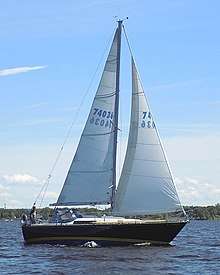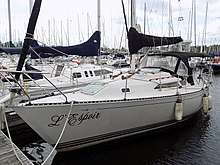C&C 30
The C&C 30 is a series of Canadian and American sailboats, that was first built in 1973.[1][2][3]
 C&C 30-1 | |
| Development | |
|---|---|
| Designer | Cuthbertson & Cassian |
| Location | Canada |
| Year | 1973 |
| No. built | 800 (Mark 1s) |
| Builder(s) | C&C Yachts |
| Boat | |
| Boat weight | 8,000 lb (3,629 kg) |
| Hull | |
| Type | Monohull |
| Construction | Fiberglass |
| LOA | 30.0 ft (9.1 m) |
| LWL | 24.92 ft (7.60 m) |
| Beam | 10.00 ft (3.05 m) |
| Hull draft | 5.0 ft (1.5 m) |
| Engine type | Universal Atomic 4 gasoline engine |
| Hull appendages | |
| Keel/board type | fin keel |
| Ballast | 3,450 lb (1,565 kg) |
| Rudder(s) | internally-mounted spade-type rudder |
| Rig | |
| General | Masthead sloop |
| I (foretriangle height) | 39.00 ft (11.89 m) |
| J (foretriangle base) | 13.50 ft (4.11 m) |
| P (mainsail luff) | 34.00 ft (10.36 m) |
| E (mainsail foot) | 11.50 ft (3.51 m) |
| Sails | |
| Mainsail area | 195.50 sq ft (18.163 m2) |
| Jib/genoa area | 263.25 sq ft (24.457 m2) |
| Total sail area | 458.75 sq ft (42.619 m2) |
The initial models were built by C&C Yachts of Niagara on the Lake, Ontario, in Canada.[1] The newest model, the C&C 30 One Design, was built by USWatercraft, LLC under the C&C brand, in Newport, Rhode Island until their entry into receivership in July 2017.[4][5]
Design
The C&C 30 series are all small recreational and racing keelboats, built predominantly of fiberglass, with wood trim. There have been four boats to carry the C&C 30 designation, each a completely different design.[1][2]
Operational history
In a review Michael McGoldrick wrote, "The C&C 30 probably did more than any other boat to establish the 30 foot size range in the minds of many Canadian sailors. Like the C&C 27, it also has to be considered a classic among the production fiberglass boats built in the country. In fact, its appearance and layout is very similar to the C&C 27, just more of everything, including some extra elbow room down below. This is a well built boat with good performance, and it did much to elevate C&C to the status of one of North America's premier sailboat manufacturers during the 1970s and 1980s."[6]
Variants
- C&C 30-1 (Mark 1)
- This model was designed by Cuthbertson & Cassian, introduced in 1973 and over 800 were built.[7] It has a length overall of 30.00 ft (9.1 m), a waterline length of 24.92 ft (7.6 m), displaces 8,000 lb (3,629 kg), carries 3,450 lb (1,565 kg) of lead ballast and has a masthead sloop rig. The boat has a draft of 5.00 ft (1.52 m) with the standard keel and 4.2 ft (1.3 m) with the optional shoal draft keel. The boat was initially fitted with a Universal Atomic 4 gasoline engine. This was replaced with a Japanese Yanmar QM15 diesel engine and later a Yanmar 2GM diesel. It has a hull speed of 6.69 kn (12.39 km/h). Later boats built had a large number of small changes to the design, including new windows and rudder mounts[1][2][8]
Robert Ball commented on the C&C 30 Mk.1, noting George Harding Cuthbertson's guidance:
The C&C 30 was my first Lines Drawing, but it was Big George telling me what to do.
The design was very much a development of the 27. Once we started being able to actual 'compare' the stability of different designs- it turns out the 30 is the most stable boat we ever did.
Listening to owners over the years, the boat is stable and tough (indestructible) and will last forever
In a review for Canadian Yachting John Boros wrote, "Production began in 1973 and ceased in 1985 -- a 12-year period that represents the longest production run of any single design version in the history of C&C Yachts. Although more 27s were built, in excess of 1,000, over a similar 12-year production period, with four distinct design phases, the 27 underwent comparatively continual change in relation to the 30, having only the one design version.
According to Steve Kiemele, of South Shore Yachts, "The 30 didn't need any changes, it held its appeal. This makes it 'The Classic'."[7]

- C&C 30-2 (Mark 2)
- This later model was designed by Robert W. Ball and introduced in 1988. It has a length overall of 29.92 ft (9.1 m), a waterline length of 25.75 ft (7.8 m), displaces 8,275 lb (3,753 kg) (8,500 lb (3,856 kg) with the winged keel), carries 3,100 lb (1,406 kg) of lead ballast and has a masthead sloop rig. The boat has a draft of 5.83 ft (1.78 m) with the standard keel and 4.50 ft (1.37 m) with the optional wing keel. The boat is fitted with a Japanese Yanmar 2GM diesel engine. The fuel tank holds 33 U.S. gallons (120 L; 27 imp gal) and the fresh water tank has a capacity of 53 U.S. gallons (200 L; 44 imp gal). The boat has a PHRF racing average handicap of 144 with a high of 144 and low of 147. It has a hull speed of 6.8 kn (12.59 km/h).[9][10][11][12]
- C&C 30 One Design
- This model was introduced as a one design racer, designed by Mark Mills and was in production in 2017. The hull is made from Vinylester, E-glass with foam core, resin-infused carbon reinforced structure and features a retractable bowsprit. It has a length overall of 30.01 ft (9.1 m), a waterline length of 28.70 ft (8.7 m), displaces 3,995 lb (1,812 kg) and carries 1,579 lb (716 kg) of ballast. The boat has a carbon fibre lead bulb daggerboard and is fitted with a Swedish Volvo saildrive diesel engine of 12 hp (9 kW). The fuel tank holds 6.5 U.S. gallons (25 L; 5.4 imp gal). It has carbon fibre spars, a fractional rig and 640.6 sq ft (59.51 m2) of sail for upwind sailing and 1,643.2 sq ft (152.66 m2) for downwind sailing.[4]
See also
Similar sailboats
- Alberg 30
- Alberg Odyssey 30
- Annie 30
- Aloha 30
- Bahama 30
- Bristol 29.9
- C&C 1/2 Ton
- C&C 30 Redwing
- Catalina 30
- Catalina 309
- CS 30
- Grampian 30
- Hunter 30
- Hunter 30T
- Hunter 30-2
- Hunter 306
- J/30
- Kirby 30
- Leigh 30
- Mirage 30
- Mirage 30 SX
- Nonsuch 30
- O'Day 30
- Pearson 303
- S2 9.2
- Santana 30/30
- Seafarer 30
- Southern Cross 28
- Tanzer 31
References
- Browning, Randy (2017). "C&C 30-1 sailboat specifications and details". sailboatdata.com. Retrieved 17 January 2017.
- InterVisionSoft LLC (2017). "Sailboat Specifications for C&C 30-1". Sailing Joy. Retrieved 17 January 2017.
- Browning, Randy (2017). "C&C Design". sailboatdata.com. Retrieved 17 January 2017.
- C&C Yachts (2014). "C&C 30 One Design". c-cyachts.com. Archived from the original on 4 March 2016. Retrieved 17 January 2017.
- USWatercraft (2018). "The Receiver is seeking offers to purchase the True North, C&C, PDQ, North Rip and J/Boat lines". www.uswatercraft.com. Archived from the original on 23 August 2018. Retrieved 11 September 2018.
- McGoldrick, Michael (2018). "C&C 30". Sail Quest. Retrieved 24 July 2018.
- Boros, John (July 1988). "C&C 30 Mark I". Canadian Yachting. Retrieved 16 December 2018.
- InterVisionSoft LLC (2017). "Sailboat Specifications for C&C 30-1 SD". Sailing Joy. Archived from the original on 18 January 2017. Retrieved 17 January 2017.
- Browning, Randy (2017). "C&C 30-2 sailboat specifications and details". sailboatdata.com. Retrieved 17 January 2017.
- InterVisionSoft LLC (2017). "Sailboat Specifications for C&C 30-2". Sailing Joy. Archived from the original on 18 January 2017. Retrieved 17 January 2017.
- InterVisionSoft LLC (2017). "Sailboat Specifications for C&C 30-2 SD". Sailing Joy. Archived from the original on 18 January 2017. Retrieved 17 January 2017.
- InterVisionSoft LLC (2017). "Sailboat Specifications for C&C 30-2 WK". Sailing Joy. Archived from the original on 18 January 2017. Retrieved 17 January 2017.